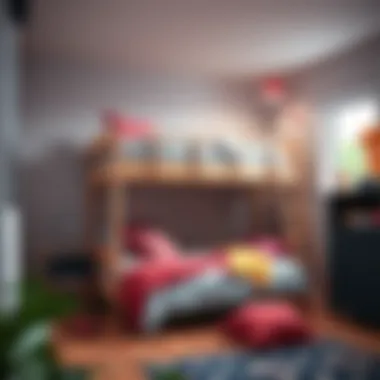Making the Most of Bunk Beds in Low Ceilings


Intro
In a world where space is often at a premium, especially in urban areas, finding solutions that maximize every square inch of your home becomes crucial. Low ceilings might initially feel like a physical limitation, but they can also inspire innovative design choices. One of the most effective ways to tackle the constraints posed by lower ceiling heights is through the use of bunk beds. This article will serve as a comprehensive guide, offering insight into how to choose the right bunk beds, the styles available, their safety considerations, and practical tips for homeowners looking to optimize their living space.
Furniture Design Styles
Overview of Popular Styles
Exploring furniture design for low-ceiling spaces often leads us to consider various styles of bunk beds. When space is tight, the design of the furnishings can either enhance or detract from the ambiance of a room. Choosing the right style is imperative:
- Modern Minimalism: Characterized by clean lines and functional design, minimalist bunk beds create an uncluttered look, perfect for small areas. Often made from light materials, they can make the room feel more open.
- Rustic Charm: If you’re after warmth and a feeling of coziness, consider bunks with a wooden frame and a weathered finish. This style integrates perfectly into a cabin-like setting or a home aiming for a welcoming vibe.
- Industrial Chic: With metal frames and a raw, unfinished look, industrial bunk beds can lend an edgy touch to a room. This design works particularly well in loft-style apartments.
- Space-Saving Designs: Some bunk beds come with built-in ladders or even shelving. These innovations help make the most of limited vertical space while providing necessary storage.
How to Mix and Match Styles
Finding harmony when mixing design styles may seem daunting. However, some guidelines can make the process easier:
- Color Coordination: Stick to a cohesive color palette that ties different styles together—like pairing a chic industrial bed with softer, muted tones in bedding and decor.
- Material Balance: Mix wood and metal thoughtfully. A metal bunk bed can look striking if you've got wooden accents elsewhere in the room.
- Functionality First: Ensure that pieces, regardless of style, serve a purpose. A beautifully designed bunk bed should not only enhance aesthetics but also provide practical benefits such as storage.
"Good design is not just about how it looks but also about how it works."
— Anonymous
Practical Tips for Homeowners
Essential Buying Tips
When it comes to selecting the right bunk bed, there are several key considerations. Here are some pointers to guide your purchase:
- Measure Twice, Buy Once: Knowing your ceiling height is non-negotiable. Be sure to account for mattress thickness when taking measurements; keeping at least two feet of clearance from the ceiling is advisable for comfort and safety.
- Safety Features: Look for beds with safety rails, solid construction, and a sturdy ladder. You want to ensure that the sleeping area is secure, especially if children will be using it.
- Weight Capacity: Always check the weight limits specified by the manufacturer. This will help prevent any unpleasant surprises down the line.
- Comfort Matters: Opt for quality mattresses. Investing in bedding that offers a good balance of support and comfort will ensure a better night’s sleep.
Maintenance and Care Guidelines
Keeping your bunk bed in good shape is crucial, especially in small spaces where every piece of furniture counts:
- Routine Checks: Periodically inspect all joints and screws to ensure nothing has loosened over time. Tighten accordingly to prevent accidents.
- Cleaning: Dust and dirt can accumulate quickly, particularly in hard-to-reach areas. Regularly wipe down surfaces with a damp cloth to maintain cleanliness.
- Avoid Hesitation with Repairs: Address any issues immediately. Chip or scratch on the surface can lead to bigger problems if left unattended.
Understanding Short Ceiling Spaces
In the realm of interior design, understanding the dynamics of short ceiling spaces is paramount, especially when contemplating the addition of bunk beds. Low ceilings often present a unique set of challenges that can result in cramped settings, yet, with the right strategies, these spaces can transform into highly functional areas. Analyzing how to optimize such limited heights not only enhances aesthetics but also elevates usability in small homes, apartments, or even specific rooms like attics.
Defining Low Ceiling Measurements
Low ceilings are typically defined as those measuring less than 8 feet in height. Some homes, particularly older structures or those with slanted roofs, might have even lower ceiling heights. The significance of measurements cannot be overstated—having precise dimensions helps in selecting the suitable height for bunk beds, ensuring they fit comfortably while providing ample headroom for users. A good rule of thumb is to leave at least 18 to 24 inches of space above the top bunk to avoid feelings of confinement or risk of bumping heads.
Here are a few factors to consider when evaluating your ceiling space:
- Total height: Measure from the floor to the highest point of the ceiling, accounting for slopes or fixtures.
- Furniture height: Consider the existing furniture; items like ceiling lamps or vents can further reduce usable space.
- Aesthetic impact: Low ceilings can feel oppressive if not properly managed. Creative designs can alter perceptions of height, tricking the eye into seeing a more open area.
Common Uses for Short Ceiling Areas
Many homeowners face the challenge of low ceilings, especially in urban settings where space is at a premium. Understanding how to maximize these areas can lead to truly innovative solutions. Common uses for short ceiling areas include:
- Kids' rooms: Bunk beds are an age-old solution that maximizes space for siblings or sleepovers.
- Guest rooms: Lofted beds in guest rooms can free up floor space for other furnishings or activities.
- Home offices: In corporate work-from-home scenarios, a clever arrangement of a lofted bed over a desk can allow for a productive work environment without sacrificing comfort.
- Attic or basement conversions: These areas tend to have low ceilings, making bunk beds an ideal choice for creating cozy, multi-functional spaces.
Utilizing bunk beds in low ceiling areas helps in resourceful use of vertical dimensions, thus meeting both practicality and stylistic demands. By acknowledging the limitations and potential of short ceilings, one can design spaces that are not only livable but also vibrant.
"Maximizing the efficiency of short ceiling spaces requires careful consideration of use and design; bunk beds provide an admirable solution that serves functionality without compromising comfort."
This understanding lays the groundwork for further exploration of the benefits and designs of bunk beds, establishing a crucial link between space limitation and functional choices.
Analyzing the Benefits of Bunk Beds
When working with spaces characterized by low ceilings, bunk beds emerge as not just a practical solution but a savvy choice. These beds have gained traction among designers, retailers, and homeowners seeking to blend functionality with style, all while adhering to spatial constraints. The importance of analyzing their benefits lies in understanding how they can optimize tiny areas and meet the diverse needs of the inhabitants.
Efficient Use of Vertical Space
In a world where living spaces are shrinking, making the best use of vertical dimensions can change the game. Bunk beds, by their very nature, elevate the sleeping area, creating extra floor space beneath for various activities or storage. This vertical strategy not only enhances the area but also provides practical usability.
For instance, consider a room meant for your kids. Instead of cramming a traditional bed and a desk, installing a bunk bed allows you to fit in a workspace below and leave ample space for play. Here are several ways bunk beds can utilize vertical space:
- Stacking Sleeping Areas: Two beds in the footprint of one means doubling sleeping capacity, making them perfect for siblings or sleepovers.
- Creating Lofted Spaces: Sleeper areas above can give rise to open spaces below, ripe for a play zone or a compact desk.
- Implementing Storage Solutions: If the bed design incorporates drawers or shelves beneath, this increases storage capability, reducing clutter in tighter living areas.
Moreover, regardless of the height of the ceiling, maximizing vertical space not only alleviates overcrowding but helps in maintaining a sense of openness. Such well-designed bunk beds can truly transform a dimly lit room into one that feels larger and more welcoming.
Versatility in Design and Function
Flexibility is where the beauty of bunk beds really shines through. Not all homes are the same, and neither are the individual needs of their occupants. Bunk beds come in a plethora of styles and designs, allowing for both aesthetic appeal and practical application.
- Style Variety: From rustic wood finishes to sleek metallic designs, the aesthetic choices are immense. This enables fitting the bed into any decor scheme—from traditional to contemporary.
- Functional Adaptability: Many modern bunk beds aren’t just beds; they can morph into multi-functional units that serve as sleep quarters, casual lounges, or even study areas.
- Ease of Reconfiguration: Modular designs are increasingly popular, letting users reconfigure the beds as their needs evolve or as children grow. Bunk beds can adapt along with the dynamics of your living situation.
"The right bunk bed can redefine not just a room, but its purpose entirely."


Ultimately, whether for a cozy children's room or a creative studio space, choosing the right bunk bed hinges on the ability to blend style with practicality. This adaptability not only enhances the living experience but also serves to maximize every inch of the environment.
Overall, analyzing the benefits of bunk beds reveals their potential to revolutionize living spaces with low ceilings. The efficiency of vertical space coupled with versatile design can lend a newfound stature to any confined area, paving the way for both creative living solutions and appealing interiors.
Types of Bunk Beds Suitable for Low Ceilings
When it comes to making the most out of low ceiling spaces, selecting the right type of bunk bed becomes crucial. With limited headroom and varying dimensions in rooms, not every bunk bed will do the trick. Understanding which models work best can significantly impact both functionality and aesthetic. We'll explore traditional models, lofted designs, and folding bunk beds—each possessing unique characteristics tailored for cozy, compact living.
Traditional Models
Traditional bunk beds often come to mind first when considering space-saving solutions. These are the classic stacked beds, where one mattress sits directly above the other. While they might not seem innovative at first glance, they hold tremendous value in smaller spaces. With a standard height of about 60 inches, most traditional models can fit snugly under low ceilings while still providing an elevated sleeping experience.
One key benefit of traditional models is their sturdy construction:
- Typically made from wood or metal, ensuring durability.
- They often feature full or twin-sized mattresses, accommodating various users.
Considerations:
- Ensure there's enough clearance above the top bunk for sitting up comfortably.
- Verify the weight limits, especially if it needs to accommodate older children or adult guests.
Lofted Designs
Lofted designs elevate the sleeping area just like traditional models, but here’s the twist—they leave the space below open for a variety of uses. By raising the bed, you can create a work area, play space, or even additional storage underneath. This makes lofted designs incredibly versatile, allowing homeowners to maximize every square foot available.
Benefits of these designs include:
- Greater floor space utilization for activities or storage.
- Lower height makes for easier assembly and less intimidating for kids versus higher lofts.
However, be cautious:
- Choose models with built-in safety features and sturdy railings, especially if kids will be climbing up and down.
- Often made from lighter materials, such as metal, which might not suit all users’ preferences.
Folding Bunk Beds
When adaptability is key, folding bunk beds present an excellent solution for low ceilings. These beds can be folded away when not in use, freeing up valuable floor space. They’re particularly appealing for multifunctional rooms or smaller apartments where maximizing functionality is a must.
Key aspects include:
- Convenience: Perfect for guest rooms where space is tight.
- Flexibility: Can quickly change a room’s layout from a sleeping area to a social space.
However, potential drawbacks exist:
- Not always built with the same sturdiness as traditional or lofted models.
- It’s essential to check for strong locking mechanisms to ensure stability when the bed is in use.
Epilogue
Each bunk bed type brings specific benefits and considerations for those tackling the challenges of low ceiling spaces. When selecting between traditional models, lofted designs, and folding options, consider the room’s dimensions, the users' needs, as well as functionality over mere aesthetics. By taking the time to understand the different types, you're empowering yourself to make the most of your living quarters, striking a balance between style and practicality.
Selecting the Right Bunk Bed
Choosing a bunk bed for a low-ceiling space can be a nuanced task, and it’s crucial to understand the selection criteria that can make a significant difference in both functionality and safety. The right bunk bed is not just about aesthetics; it’s about filling a need without cluttering the limited vertical space you have. In this section, we will dive into various essential aspects that must be considered when selecting a bunk bed, ensuring that the final choice meets personal needs, enhances the space, and keeps safety in the forefront.
Measuring Your Space
Before diving into the options available in the market, measuring your space is vital. This isn’t just about checking the height of your ceiling; it’s about obtaining precise dimensions that will allow you to visualize where the bunk bed will fit best.
- Height: Start by measuring from the floor to the ceiling. Low ceilings, typically defined as anything less than 8 feet, demand careful consideration of how tall a bunk bed can be. Remember to account for any light fixtures, ceiling fans, or molding that might interfere with headspace.
- Footprint: Next, evaluate the floor space. Measure the area where you intend to place the bunk bed. It’s important to ensure that the width and length will leave adequate room for movement and any additional furniture, such as desks or storage.
- Accessibility: Think about the space required for ladders or stairs, particularly if you have children who need to access the top bunk. This can influence both the design of the bed and how much space is left for other items.
Evaluating Material Options
Bunk beds come in various materials, each with its pros and cons that can significantly affect durability, aesthetics, and comfort. An informed decision about materials can greatly enhance the longevity and appeal of your bunk beds.
- Wood: Solid wood is often favored for its sturdiness and timeless look. It provides a warm aesthetic but can be on the heavier side, which is something to consider in terms of installation and movement.
- Metal: Metal frames are usually lighter and can often support a more minimalist design. They are durable and provide a modern appearance. However, depending on the type, they can be less inviting, especially in a child's room.
- Composite Materials: Many contemporary designs incorporate engineered wood or laminate. While these can be cost-effective, it’s essential to evaluate their long-term durability compared to solid wood or metal options.
Choosing Safe Designs
Safety is paramount when it comes to bunk beds, particularly in low ceiling spaces. Here are specific aspects to consider:
Sturdy Railings
Sturdy railings are essential for any bunk bed; they serve as a critical safety feature that prevents falls. A well-designed bunk bed will have railings that are high enough to provide effective protection, usually around 5 inches above the mattress. This height ensures children stay secure while sleeping, which is particularly important in environments where they might shift in their sleep.
The best railings are made from solid materials that can withstand pressure and wear over time. Opt for designs that feature continuous railings without gaps, as this prevents limbs from slipping through. Having railings that are easy to grip can also make getting in and out of bed safer, which is why they are considered a fundamental aspect of bunk bed design.
Height Considerations
With low ceilings, understanding height considerations is crucial to avoid having the top bunk feel like a cave. Choose designs that maintain adequate space between the mattress and the ceiling. Ideally, there should be at least 2 feet of clearance from the top of the mattress to the ceiling. This ensures comfort while sitting up and helps avoid accidental bumps to the head.
Additionally, look for adjustable bunk beds that have options for different heights. These can adapt to multiple spaces and needs over time, making them a versatile choice.


Weight Limit
Every bunk bed comes with specific weight limits, which are often determined by its construction materials and design. This factor is particularly important to consider for safety and longevity. Most standard bunk beds can safely support weights between 200 to 400 pounds, but it's wise to check the manufacturer's specifications.
Understanding the weight limits is crucial to ensure that the bed can accommodate its intended users, particularly if the design is meant for children, teenagers, or adults. The weight limit should include not just users, but also bedding and any additional items placed on the top bunk. By selecting a model with a generous weight limit, you can safeguard against potential accidents and contribute to the overall durability of the bed.
In summary, selecting the right bunk bed involves a careful alignment of space measurement, material evaluation, and a focus on safety features. Each of these elements plays a part in creating a functional, stylish, and secure sleeping environment within limited vertical spaces. An informed choice results not just in practicality but also contributes to a harmonious design in your living space.
Design Aesthetics for Short Ceilings
When working with low ceiling spaces, design aesthetics can become a critical element that either elevates or diminishes the usability of the area. Rather than merely cramming furniture into tight spots, an organized and planned approach can transform a compact room into a charming living space. Understanding how color schemes and accessories work together can create the illusion of height and openness, ultimately making the environment more comfortable and visually appealing.
A well-harmonized design offers numerous benefits, such as enhancing lighting, improving the overall mood, and making the space feel roomier. By carefully selecting your color palettes and the right accessories, you can not only blend functionality with beauty but also create an inviting atmosphere that resonates with personal style while addressing the constraints of a low ceiling.
Color Palettes to Consider
Choosing the right colors for a short ceiling area is all about creating an illusion of height and openness. Light colors, such as soft whites, pale blues, and light greys, tend to reflect light better, making the space feel airier and larger. Alternatively, darker shades can be used strategically, perhaps on an accent wall, to create depth without overwhelming the room.
- Use of Contrasting Colors: By playing with contrasting colors, you can draw the eye upwards, guiding the viewer's focus away from what feels cramped and instead highlighting the vertical space.
- Monochromatic Schemes: Another effective approach is utilizing a monochromatic color scheme. By deploying varying shades of the same hue, it fosters a seamless look that can expand the perceived dimensions of space.
Incorporating Accessories
Accessories play a crucial role in shaping the final ambiance of a room with low ceilings. They can serve both functional and decorative purposes. The right accessories can enhance space usage while adding character and warmth.
Lighting Choices
Selecting appropriate lighting is essential for short ceiling spaces. Opting for ceiling-mounted fixtures can help maintain an open flow, while lamps that cast light upwards can create a perception of greater height. Essential characteristics such as energy efficiency and style also factor heavily. Fixtures with slim profiles can provide illuminating effects without an overpowering presence, embodying a modern aesthetic.
A popular choice among designers is pendant lights hung at varying heights. This creates an engaging visual dynamic and adds a sense of depth to the space. However, care should be taken to not clutter the ceiling with too many features, which can feel oppressive rather than heightening.
Textiles and Bedding
One cannot underestimate the impact of textiles and bedding in enhancing the overall feel of a low ceiling room. The choice of materials can dramatically define comfort while fulfilling aesthetic desires. Lightweight and breathable fabrics can keep the atmosphere light, while heavy or dark textiles might contribute to a feeling of confinement.
Interesting textures introduce dimension without adding bulk. Consider using lighter duvet covers and airy curtains. This not only aligns with the choose of color palettes but also ensures ease in maintaining visual flow. However, it’s important to balance colors and textures—heavy bedspreads will weigh down the room if not mixed well with lighter hues or patterns.
In summary, design aesthetics in low ceiling areas requires deliberate and thoughtful decision-making. Taking into account how colors and accessories interplay can turn a constrained space into a stylishly versatile living area. Striking that balance opens the door to endless possibilities, granting both functionality and flair.
Practical Tips for Maximizing Low Ceiling Areas
When it comes to creating an inviting space in areas with low ceilings, every square inch counts. Optimizing these spaces goes beyond just placing a bunk bed in the corner. It’s about strategic planning and dynamic design choices that allow you to not only fit in furniture but also maintain comfort and functionality. This section touches on some practical tips that can help you make the most out of your low ceiling area, ensuring that it feels more open and usable.
Using Multi-Functional Furniture
Multi-functional furniture serves as a game changer in compact spaces. When space is at a premium, you really want to select items that can serve more than one purpose. A bunk bed that incorporates a desk, for instance, gives a child a cozy spot to study right below their sleeping area.
Here are some ideas for incorporating multi-functional furniture:
- Storage Bunks: Look for bunk beds that include built-in drawers or shelving, allowing you to store extra bedding or toys without needing additional furniture.
- Daybed Solutions: Consider a daybed that can easily convert into a twin bed at night. It serves as a couch during the day — perfect for small rooms!
- Foldable Elements: Foldable desks or wall-mounted tables can be a great addition, popping up when needed and collapsing when extra space is required.
This flexibility allows maximization of both floor space and usability, letting the area perform various functions without a cluttered feel.
Creating Vertical Storage Solutions
Low ceilings often lead to the misconception that vertical space is of little value. In reality, it’s your best friend! Finding creative ways to use vertical storage can completely alter the utility of a shorter room. Think of it this way: high shelves can store items that you rarely use, keeping the floor area clear and the space feeling larger.
Here’s how to implement vertical storage:
- Wall-Mounted Shelves: These can hold books, decorative elements, or even plants, drawing the eye upwards and adding dimension to the room.
- Tall Cabinets: Instead of wide, bulky furniture, opt for cabinets that rise high. This strategy not only saves floor space but also adds vertical interest.
- Hanging Organizers: Utilize hooks, pegboards, or hanging baskets. They can contain a variety of items from arts and crafts supplies to keys and bags, decluttering that precious floor area.
Effective vertical storage can make a low-ceilinged space not just tolerable, but desirable!
By applying these practical tips, anyone dealing with low ceiling spaces can enhance their surroundings in ways they never thought possible. The key is to think outside the box and prioritize functionality without sacrificing style.
Safety Considerations in Bunk Bed Selection
Bunk beds can be a godsend for low-ceiling spaces, but choosing the right one is crucial for safety. You don’t want to end up with a setup that looks good but poses risks, especially in homes with children or teenagers. Understanding how to identify safe designs will give every homeowner peace of mind while maximizing their space effectively.
Evaluating Age Appropriateness
Age can’t be overlooked when picking out a bunk bed. Each design has its audience, and knowing who will use it helps in making smart choices. Generally speaking, while there’s no hard and fast rule, kids below six years old should not be on the top bunk. Their motor skills and judgment are still developing, which makes falls more likely.
When considering your options:
- Young Children (under 6): Look for models that are lower to the ground and have side rails that are robust.
- Middle Childhood (6-12 years): Options that provide a sturdy frame and are pitched towards this age range are acceptable. Ideal designs are those with easy access stairs and strong railings.
- Teenagers: For older kids, the emphasis shifts to the style and structure. They may swing from a more conventional design to a lofted bed style. Nonetheless, check for solid support and ensure that safety features remain intact.
Preventing Accidents
Any safety considerations must also account for preventing accidents that can occur within bunk bed frames. This means taking a hard look at both the design and the placement in your room.


Start with the core structure:
- Sturdy Construction: A bed should be stable. Models made of solid wood or durable metal often provide better stability.
- Weight Limits: Always adhere to weight limits specified by the manufacturer. Overloading a bed increases the risk of structural failure.
- Guardrails: Ensure that the bunk bed comes with full-length guardrails. They should be at least five inches above the mattress level to effectively deter falls.
- Ladder Safety: Check that the ladder is securely attached and designed for easy climbing. A wobbly ladder can increase chances of stumbles.
Next, consider the surrounding space:
- Flooring: Position the bed over a soft rug or carpet to cushion any falls that might happen.
- Furniture Layout: Avoid placing the bed too close to windows or hanging items that could pose a risk.
- Clear Pathways: Make sure no clutter blocks access to and from the bed.
"Prioritizing safety while selecting a bunk bed is as essential as ensuring it fits aesthetically in a room. A balance of form and function creates an ideal environment for sleep and play."
Keeping these tips in mind will help ensure that your decision not only enhances the space but safeguards the well-being of those using it.
Installation and Assembly Considerations
When it comes to choosing bunk beds for low ceilings, the installation and assembly process can often feel like the unsung hero of furniture shopping. Understanding this aspect is crucial as it can greatly impact both the functionality and safety of your chosen model. A well-assembled bunk bed not only stands the test of time, ensuring durability, but also enhances the aesthetic appeal of a compact space.
Assessing DIY Skills
Before diving into the assembly of a bunk bed, it's essential to gauge your DIY skills. The effectiveness of your bunk bed assembly hinges on your comfort level with basic tools and instructions. Some aspects to keep in mind include:
- Tool Proficiency: Do you own and know how to use essential tools like screwdrivers, wrenches, and possibly a drill?
- Instruction Comprehension: Are you capable of following assembly instructions without getting lost in the jargon?
- Problem-Solving Skills: Will you be able to troubleshoot issues that might arise during the setup?
Taking the time to assess these factors can prevent costly mistakes and frustration. If you lean towards a more hands-on approach, ensure you set aside ample time while keeping at bay any distractions—working in a cluttered space can muddle your focus and result in a shoddy setup.
"Proper assembly transforms a simple bunk bed into a safe and cozy oasis, suitable for any low-ceiling environment."
Once you’ve decided that it’s feasible to take the DIY route, don't forget to prepare your area for assembly. Clearing the space and laying out all components and tools in an organized manner can simplify the process, making it less intimidating.
Professional Setup Options
For those who prefer to leave it to the experts or simply wish to ensure every bolt and screw is in its rightful place, hiring professionals for assembly might be the wisest move. Engaging a professional service comes with several benefits:
- Expert Installation: Professionals have experience with various models and know intricate nuances regarding their assembly, leading to safer and sturdier setups.
- Time-Saving: Leaving the hard work to someone seasoned allows you to focus on other aspects of your home, such as styling around your new bunk bed.
- Warranty Protection: Some manufacturers might require professional assembly in order to uphold warranties, meaning if something goes awry down the line, you’re covered.
To find reputable installation services, you might turn to local home improvement stores or service directories like HomeAdvisor or Angie’s List. Check reviews and ratings for a sense of the service quality before committing.
Maintaining Bunk Beds in Limited Spaces
Keeping bunk beds in good condition is a crucial aspect when dealing with low ceiling areas. This goes beyond merely ensuring aesthetic appeal. Regular maintenance helps prolong their lifespan, ensures safety, and enhances functionality, allowing one to fully enjoy the advantages of vertical living.
Regular Safety Checks
When it comes to bunk beds, safety is non-negotiable. Regular safety checks should be a top priority, particularly in confined spaces where movements are restricted. Here are some elements to consider:
- Sturdiness of the Frame: Examine the bed frame for any signs of wear and tear. This includes checking for rust, loose screws, and any cracks that could jeopardize stability.
- Rails and Guard Bars: Secure guard bars prevent accidental falls, particularly from the upper bunk. Make sure they are installed correctly and remain firmly in place.
- Mattress Integrity: A good mattress should fit snugly within the bunk bed frame. This prevents it from slipping and reduces the risk of accidents.
- Overall Structure: Periodically check that the bunk bed remains level. Uneven surfaces can create imbalances, making the bed unsafe.
It's wise to consider a routine schedule for these checks. For some, once every three months works well, while others might need more frequent evaluations due to heavier usage. Make it a family habit, where kids can also participate in checking the bed, fostering a sense of responsibility for their own safety.
"Regular checks transform a bunk bed from just a piece of furniture to a safe haven for those who use it."
Cleaning Protocols for Compact Areas
Cleaning a bunk bed in limited spaces can pose challenges, but it’s essential for maintaining hygiene. Here are practical cleaning protocols:
- Dust and Debris Removal: Use a microfiber cloth or duster to eliminate dust that settles on the frame and around the mattress. For tight spots, a vacuum with a hose attachment can reach areas where usual cloths cannot.
- Washing Bedding: Regularly launder all bedding including sheets, pillowcases, and blankets. This should ideally be done every two weeks to reduce allergens, especially if the bunk bed is in a children's room.
- Clean Underneath: Not often considered, cleaning beneath the lower bunk is vital. Dust bunnies and accumulated dirt can reduce air quality. Slide out any items stored there, and sweep or vacuum thoroughly.
- Disinfect Hard Surfaces: Use an appropriate disinfecting wipe or solution on hard surfaces, ensuring you get into every nook and cranny.
Establishing a cleaning schedule can turn this task into a regular routine. Set a reminder every month to give the bunk bed a thorough clean. This ensures that the environment stays fresh, healthy, and welcoming for its users.
By maintaining bunk beds in compact spaces through these safety checks and cleaning practices, you not only ensure longevity but also create an inviting atmosphere that continues to serve its purpose in your home.
Customer Perspectives and Case Studies
When it comes to optimizing low ceiling spaces using bunk beds, real-world insights can provide valuable context. Customer perspectives offer a unique window into the practical implications of various models. Understanding how different users navigate challenges and preferences in compact areas can guide both designers and retailers in meeting specific needs. The benefits of such perspectives are numerous; they illuminate trends, highlight potential pitfalls, and underscore the significance of user experience in the design process.
Moreover, case studies can serve as a guiding light for those who have faced similar constraints. They allow homeowners and designers to analyze what works and what doesn’t, fostering a better decision-making process. In this context, examining real-life experiences offers practical advice that goes beyond theoretical application, effectively bridging the gap between concept and reality.
User Experiences with Various Models
User feedback on models available in the market can vary widely, often reflecting individual needs and preferences. For instance, parents may look for durability and safety in bunk beds while young adults may prioritize aesthetics and versatility.
- Sturdy Traditional Models: One family shared their experience with a classic wooden bunk bed, praising its robust structure and timeless appeal. They felt reassured about safety, as the solid design kept their children secure. However, they noted that the height restrictions made climbing in and out slightly cumbersome for their teens.
- Space-Saving Lofted Designs: Another customer installed a lofted bed to maximize floor space. They transformed the area beneath into a cozy workspace. This design garnered applause for both functionality and the ability to transform a tight area into a multi-purpose zone. Unfortunately, some users highlighted concerns about headroom, particularly for taller individuals.
- Folding Bunk Beds: For those with fluctuating space needs, a folding bunk bed model proved useful. One user loved how it could be conveniently stowed away during the day, allowing for a clean and open environment. Yet, they also expressed frustration with the time taken to set it up.
These candid reflections help build a broad understanding of how different models serve diverse user needs.
Comparative Analysis of Designs
When analyzing various designs of bunk beds, one must account for architectural, aesthetic, and user-oriented elements. The interplay between these aspects creates a delicate balance that can sway decisions. Considerations in this comparative analysis include:
- Height and Safety: Traditional models tend to offer a greater sense of security, particularly with higher side rails. In contrast, lofted designs might risk less stability, primarily influencing families with younger children.
- Space Efficiency: Lofted beds are popular among urban dwellers, as they maximize vertical space while leaving ample room beneath for desks or play areas. Folding options beat them when it comes to versatility and space management but may not provide the same look of permanence.
- Material Choices: Users often argue over the best materials. While wood provides a classic charm, metal models tend to be lighter and more modern, attracting a younger demographic. This dichotomy highlights the necessity of personal taste versus practical functionality.
"Choosing the right bunk bed isn’t merely about style; it’s about understanding your environment and what fits best within it."
Through thoughtful examination and user feedback, a clearer path emerges for selecting appropriate bunk beds tailored for low ceilings. This can take some of the guesswork out of the equation, efficiently guiding those who might feel overwhelmed by options.
By fostering a dialogue about user experiences and design comparisons, these insights can enhance decision-making for designers, retailers, and homeowners alike, ensuring that each choice reflects both form and function.















